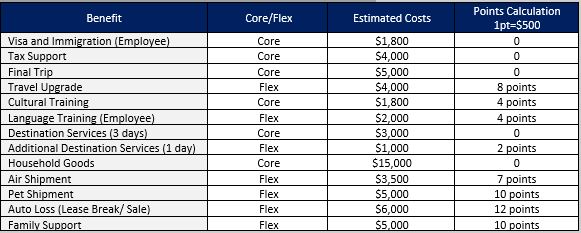Blog
Core-Flex Mobility Models
Aligning Your Approach with Company Goals
When an organisation is considering a core-flex approach to mobility, a variety of drivers may be behind the decision. Some companies are hoping to control mobility costs. Some want to minimise exceptions. Others have an eye on improving the employee experience during a relocation. Whatever the reason, truly defining what the company hopes to accomplish is an important ‘first step’ when deciding whether to use a core-flex approach at all. The importance is twofold:
First, there may be other action steps and approaches that would better accomplish company goals, or that would assist in combination with a core-flex mobility model; identifying these action steps and approaches will be key to ensuring that the chosen core-flex model succeeds.
Second, there are multiple ways to design and implement a core-flex model. If a core-flex approach is adopted, defining specific goals will help to identify the best flex-benefit administration approach that should be used to meet those specific goals. Working closely with an experienced mobility provider is advisable, as their extensive experience and expertise can help to pinpoint unimagined solutions and to guide informed decisions around core-flex design and implementation.
The document that follows will discuss core-flex approaches to mobility: what core-flex is, varying models and considerations for each.
What is Core-Flex?In a core-flex mobility approach, flexible components are usually offered within company-established guidelines and/or limitations, in addition to a core set of services that are provided to all employees within the same group or move type. In theory, this should result in packages that can be tailored to address employee preferences and employer goals and objectives, providing relocating employees with services they do need while omitting those that they don’t. Core-flex models can support multiple mobility strategies, without a need to manage multiple policies or tiers. This can be particularly appealing to organisations with diverse mobility populations and demographics and/or diverse business needs or approaches to mobility. Various departments and stakeholders will often have various agendas, drivers and strategies when considering mobility, ranging from cost control to employee experience. Addressing these will be key to designing the right approach to fit the organisation. Because the unique needs of each organisation drive design, the structure of core-flex programmes will vary from company to company. What should remain consistent, across the board, is the inclusion of core benefits that ensure compliance with tax and immigration requirements (e.g. visa and immigration services, tax advisement services, etc.) and that provide the benefits a company determines are the basics for a successful relocation. There are also some pros and cons that are consistently shared amongst core-flex methodologies. Understanding these factors is helpful to choosing the right approach; read our blog post, Core-flex Mobility Programmes: Advantages and Challenges, for more information. |
You’ve Decided to Use a Core-Flex Approach: Considerations
Only when an organisation understands the challenges and expected benefits of a core-flex mobility model – and then clearly defines its goals – are they truly ready to embark on designing a company-specific core-flex mobility approach. There are several factors to consider when getting started. To begin, let’s define a core benefit versus a flex benefit:
Core Benefits
Core benefits are ‘hardcoded’ into a programme, meaning they must be provided to the employee based on an established, eligible move type or tier. These may include the items listed below, but should always reflect necessary elements for compliance and with duty of care in mind:
- Travel to the destination location
- Home sale/home purchase assistance
- Visa and immigration assistance
- Tax briefing and return support for the duration of the assignment
- An element of household goods support, with minimum air freight
- Temporary housing for 30 days
- Expense reimbursement
 Flex Benefits
Flex Benefits
Flex benefits are typically a predetermined set of benefits that the business, employee, or a combination of both select from to support specific needs. These benefits may be offered in interchangeable ways (such as an employee substituting an offering they may need [e.g. home search support] “in place of” an offering that they don’t [e.g. school finding support]. Alternatively, flex benefits can be offered “as” a core benefit, with the flexible component being that the business determines the level or type of support that will be provided (minimal support, a moderate level of support or a high level of support); this determination would be based on the employee’s move type or tier of eligibility, company budget, the move driver (employee choice vs company need), and/or employee/business need.
Delivery models of flex benefits are numerous and are designed with business and employee needs and objectives in mind. Employees and/or the business have a measure of flexibility to choose and apply benefits that are needed, while opting out of those that aren’t. When appropriate, spending caps may be applied to individual tiers or move types. Examples of flex benefits could include:
- Home-finding support
- Settling-in support
- Tenancy management
- Housing contributions/full compensation
- Household goods shipments
- Pet shipment
- Property management
- Permanent storage
- Language training
- Cultural training
- Education/school-search support
- School fees and/or tuition
The interchangeability of flex benefits and/or providing varying levels of support allows employers to:
- Provide a more positive employee experience to a more diverse group of employees and their accompanying partners and families (for example, an executive with a family of four, large home and a family pet may need a higher level of support on an intercountry move than a single employee who is renting).
- Offer additional or increased levels of support to improve the employee experience and enhance their mobility brand and talent management efforts (using the above as an example, since the recent university graduate requires fewer services [e.g. no need for the transport of high-value household goods or a school search] the company may choose to provide higher-level home search services, intercultural training, etc.).
- Structure their policies in a way that accounts for employee equity and differentiation, simultaneously
- Provide household-specific support
Employee-Driven Core-Flex Delivery Options
Core-flex approaches that are driven by employee flexibility are more common in domestic US programmes than with global cross-border programmes. When used, the delivery methods are just as varied as the offerings themselves can be. Employee flexibility-driven models typically fall into one of four standard approaches:
|
Method 1: Menu Approach |
| Employees are offered a menu of flexible benefits that they are eligible to select from (e.g. 9 total flex benefits listed). |
| Employees are allotted a predetermined number of flex benefits that they are permitted to select (e.g. 6 flex benefits of the 9 available). |
| The number of flex benefits allotted is typically based on tier/employee level or the relocation driver (employee choice, business need, etc.). |
|
Ideal application: This approach works well when the costs for menu options are similar. This approach also works well when the core benefits cover a majority of the necessary benefits and the flexible benefits are meant to provide the enhancement of support, additional support or ancillary relocation services. Application tip: Menu approaches should provide employee flexibility to enhance their experience. However, this approach should not require an employee to choose between benefits they need; requiring this and, potentially, causing them to go without a necessary service could leave them at a disadvantage. |
| Method 2: Monetary Cap Approach |
| This method is sometimes referred to as a “dollar value cap” or, simply, “capped”. |
| A monetary cap on flexible benefits is set. |
| The cap can be set at the individual benefit level and/or cumulatively for all flex benefits, but most organisations typically place a monetary cap cumulatively for all flex benefits. |
|
While the capped approach can be attractive in theory, the reality is that administering a capped programme can be cumbersome for the employee. All costs over the allowed caps would become out-of-pocket expenses/responsibilities for the employee. Thus, the “expected” flexibility can come at a price for employees, who become subject to the added stress of managing their relocation on a budget – often with little to no prior knowledge or experience. This, combined with the typical stress of a relocation, can take its toll and can have a negative impact on both the employee and employer. The employee can suffer, as they contend with troubleshooting they may not be prepared to handle. The employer may be forced to apply unexpected resources (financial and administrative) to assist with troubleshooting – and lose the relocating employee’s focus on job-related responsibilities. Ideal application: This approach can be ideal when 1) allocated costs can easily cover the benefits the employee can choose from and 2) benefits coordination is provided by the RMC. Application Tip: Employees should not be provided cash in lieu of support or ‘cash out’ of unused funds in the budget/cap. Example No.1: The employee is provided a relocation budget of $30,000 and can use the budget against a set of pre-defined relocation benefits. Example No.2:The employee is provided a list of benefits, to be provided with a cap:
|
| Method 3: Points-Based Approach |
| Each flex benefit is assigned a point value based on its average or range of cost. |
| Employees are allotted a predetermined number of points to be used for flex benefit components. |
| The number of points available is typically based on tier/employee level or the relocation driver. |
|
This approach will require expertise, due diligence and an understanding of company culture to design a programme that will be effective. Keep in mind that employees can easily determine the dollar value of a point and, if the full dollar value of the points available regarding a benefit are not spent, employees tend to be dissatisfied or feel short-changed. This may or may not be an issue for a company based on their unique culture. Ideal application: Ideal for programmes that have a strong core set of benefits and in which the points can be used for benefits that enhance the employee experience. Not recommended for programmes where all relocation benefits or critical benefits are chosen through a point system. Application tip: The points methodology provides a mechanism for employee flexibility; actual costs may come in higher or lower than estimated costs and should not be viewed as a capped move programme. Example: Employee has 30 points to use towards Flex Benefits
|
| Method 4: Lump Sum Approach |
| A lump sum is provided to assist with designated flex benefits that would have typically been provided as part of a reimbursement. |
| The lump sum to be offered can be calculated, based on the average historical cost of the benefits the lump sum is intended to cover. This number can then be reduced if the company’s main goal is to reduce costs. |
| Employees can, ultimately, spend funds however they wish, as receipts are not required. |
|
In this model, there is a high risk of the mismanagement of funds by relocating employees, who simply don’t have enough experience or knowledge regarding timelines, conserving/rationing funds and/or the nuances of a given location. For more information on the considerations associated with lump sum mobility approaches, and the management of this methodology, please see our recent blog posts on this topic. Ideal Application:This model is best used in cases in which the company hopes to improve the employee experience by eliminating the need for reimbursements. Ideally, the employee would not need to use their own cash, save receipts, submit for reimbursements and/or wait to be reimbursed. Example: An $8,000 lump sum is provided to use towards a house hunting trip and final move costs Example: A $5,000 lump sum is provided to use towards family support in the new location Application Tip: Lump sum payments are best utilised when paired with employee guidance on best lump sum use practices. Working with an experienced relocation management provider that provides easy-to-use technology can be extremely useful in this regard. |
Business-Driven Core-Flex Delivery Options
Core-flex approaches that are driven by business goals are more common in cross-border mobility programmes than in domestic ones and many organisations are either changing to or investigating core-flex programmes due to pressure or push back from their business leaders. As mentioned earlier in this document, some organisations are exploring ways to manage costs, while others hope to enhance the employee experience. In some cases, the expectation is that a core-flex approach will provide the business with more control and flexibility to hire the talent they need, where they’re needed.
Through a core-flex approach, decision-makers aren’t limited by a traditional policy approach that might require multiple exception requests to secure a candidate they’d prefer. Structures can be tiered and/or the core benefits can be variable, based on job/role, tier, driver, budget and/or the desired employee experience the company wishes to provide.

When the driver behind a core-flex approach is business-driven, we’ve noted that the management of flex components can be delegated to business units or the business manager – empowering business units or the HR team to manage their own mobility budgets. Doing so ensures that basic levels of compliance are adhered to, while offering options to create a benefits plan that aligns with their recruitment and talent management needs.
Core-flex is also quite helpful when supporting employee requested moves, in which core components would include compliance-related support (such as tax and immigration services). Meanwhile, the business maintains the flexibility of offering no further services, or minimal support for household goods shipment, travel to the new location, or a small lump sum to assist with moving expenses.
Finally, an additional highlight is that core-flex approaches work well for organisations that are project-based. This can be especially helpful if the company is bidding on several projects, but can’t make the same financial investment in each. Core-flex approaches allow organisations to customise support, should a final bid erode funds that had been previously set aside for labour/relocation costs.
Conclusion
At SIRVA, we’ve noted that companies who realise the greatest levels of success with a core-flex programme share the following characteristics:
- They have clearly established and well-communicated goals and objectives for the programme.
- They have constructed their core-flex matrices and policies in ways that are easy to understand.
- Their relocation or HR teams take a consultative approach with the business units to fully explain the programme and reasons behind its implementation.
- They follow up with their business units after implementation to assess performance and make changes as needed.
- They outsource the tactical provision of services to a qualified provider, freeing their internal teams to focus on business goals and objectives – particularly helpful at a time when internal teams are smaller, and tasked with more responsibility than ever before.
If goals are not clearly defined and the core-flex model is not efficiently implemented, the approach can unintentionally create or exacerbate the very challenges it was created to address. This can result in a lack of control, increased costs, global and regional inconsistencies in application, and lower assignee satisfaction rates.
Conversely, if an organisation’s goals and objectives are clear – and its approach clearly defined – it can achieve significant benefits through its core-flex programme, including greater control over spend and a maximised ability to attract and accommodate the talent needed to meet evolving globalisation, remobilisation and expansion.
To learn more about the many ways SIRVA can help organisations align their core-flex programme with company goals – and identify additional action steps to achieve those goals – contact us at concierge@sirva.com.
Contributors:
- Kathy Burrows, Director, Global Advisory Services
- Angela Chrz, Manager, Global Advisory Services
For more information please see SIRVA’s Blog Disclaimer.


